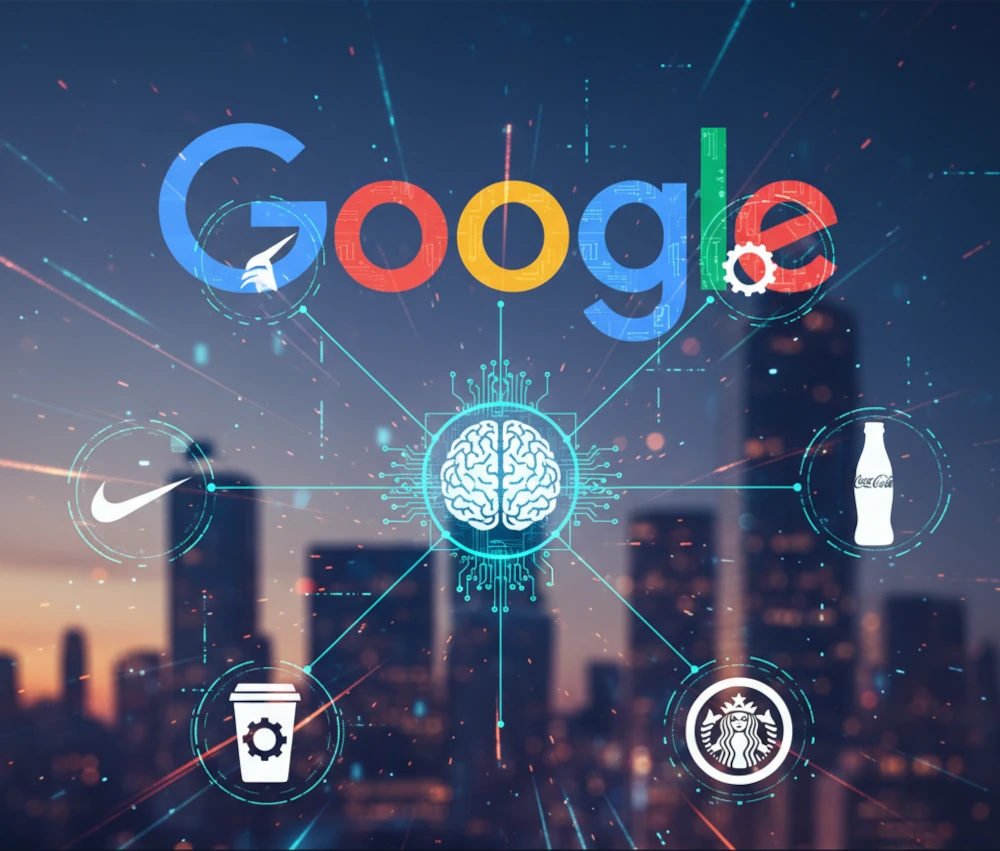It is time to reconsider the way Google Ads functions, due to artificial intelligence that introduces automation, targeting, and creativity to a previously unseen level. However, as Google AI advertisements become more intelligent, a question many brand owners are posing is what it means to us.
This guide breaks it down simply. We will examine the operations of the new AI-driven ad capabilities at Google, their advantages and disadvantages, and how brands can adjust their marketing efforts to keep them afloat. This article is useful no matter whether you do paid campaigns or digital strategy because it will help you realize how AI can assist, rather than harm your brand.

What is Changing in Google’s AI-Powered Ads?
The change doesn’t only involve smarter algorithms, but rather AI will take a lead in ad creativity, targeting, and campaign performance.
1. Generative AI in Ad Creation
Google’s latest tools, like Demand Gen and Performance Max, now use generative AI to build headlines, visuals, and descriptions automatically. You can give the system a few prompts, “a product name, value points, or tone” and Google creates multiple ad variations in seconds.
It’s not replacing marketers but rather enhancing creativity. Think of it as having an exceptionally brilliant partner that tests hundreds of ideas simultaneously to find what matches most with your audience.
2. Smarter Targeting and Predictive Insights
AI now understands user intent far beyond basic keywords. By analyzing behavior, search context, and browsing patterns, Google predicts which ad will likely convert. It’s moving from reactive targeting to predictive advertising.
So instead of manually guessing audiences, AI dynamically identifies the most interested segments, even before they search.
3. Cross-Platform Intelligence
Another major update is how Google integrates YouTube, Search, Discovery, and Gmail campaigns under one AI framework (learn more here). This allows your ad creative to adapt automatically depending on where it appears. A YouTube ad becomes more visual, while a Gmail placement focuses on text and offers.
It’s like having one unified marketing brain learning across every platform.
Why Does Google’s AI Upgrade Matter for Brands?
Now that we have drawn attention, we shall examine further what these updates imply for the brands. These changes are not merely technical modifications, but they are transforming the whole pace of business competition and interrelation offered by the Internet.
1. Data-Driven Personalization
Personalization is made more accurate through AI. Now the brands can provide messages to micro-audiences which may be delivered according to browsing patterns, use of devices and even time of the day. The result? Advertisements are annuities that are human, relevant and timely, and not intrusive.
For example, the Demand Gen campaigns by Google examine the engagement behavior of your audience on YouTube Shorts and Discover feeds, and the images they provide are attractive and not just advertisements.
2. Cost Efficiency & Better ROI
Through smarter bidding and automation, AI cuts wasted ad expenses. Machine learning identifies the lowest-cost conversions while keeping performance stable. Many brands are already reporting up to 20–30% improved ROI when fully adopting AI-led ad formats.
But it’s not magic – you still need strategy, creative direction, and clear objectives. AI amplifies good marketing; it doesn’t fix weak planning.
3. Consistency Across Channels
Before AI, marketers could only have developed individual campaigns in Search, Display, and YouTube. Today, one Performance Max campaign is capable of disseminating and changing content on all surfaces automatically.
This saves time, ensures consistent branding, and uses AI insights from one channel to improve another.
What Are the Risks or Limitations?
Naturally, each new jump in a single direction causes certain difficulties and AI-powered advertisement is no exception. The most effective way to be in them is by telling the truth and being upfront about it, as the present audiences have never been more appreciative of transparency than ever before.
1. Less Manual Control
While automation saves time, it limits manual control. You can’t always see why AI made a certain targeting choice or which creative version led to conversion. For brands that rely heavily on precise audience control, this may feel like flying blind.
2. Data Privacy and Brand Safety

AI is dependent on huge amounts of data, which is a point of concern as far as privacy is concerned. Google swears to abide by all privacy frameworks in the world, yet the brands still need to make sure that their advertisement policies and audience settings are in line with the local data protection laws.
Additionally, automated placements may sometimes show ads beside irrelevant or sensitive content. Continuous monitoring and exclusions are still necessary.
3. Creative Uniformity
When AI writes or designs too much, ads can start feeling similar across industries. To avoid “AI fatigue,” brands should add their unique tone and storytelling – things algorithms can’t replicate.
How Can Brands Adapt to AI-Powered Advertising?
However, what can you do with all this? It is high time to transform an idea into practice and mould how your brand makes use of the smarter ad ecosystem through Google to the maximum.
1. Redefine Your Creative Process
One should not look at AI as a substitute but as an assistant. Write AI-generated ads, experiment with visuals or propose suggestions on insights into the audience, but improve on the final result.
Integrate humanity with AI accuracy.
It can be just one catchy line that you write, and it can work better than 50 versions that are automated. A catchy line written by you can outperform 50 automated variations.
2. Strengthen Your First-Party Data
Google’s AI thrives on data, but your own data is gold. Collect and segment customer information from your CRM, website analytics, and email interactions. When integrated with Google Ads, this improves targeting accuracy without depending entirely on third-party cookies.
3. Focus on Storytelling
Even with smart automation, storytelling remains your strongest branding tool. Whether it’s a 6-second YouTube bumper ad or a Discovery carousel, focus on the emotional hook – curiosity, humor, inspiration, or trust.
AI can optimize delivery, but you provide the heart of the message.
4. Test and Learn — Continuously
Smart campaigns thrive on feedback. Test the experimental creative styles, gauge the engagement, and have AI learn based on the findings. The more it is fed, the smarter it becomes when it comes to success prediction.
Under regular audits, you are also able to identify patterns and make budget adjustments.
How Do Google’s AI Ads Impact SEO and Organic Strategy?
This question pops up frequently, particularly following the current changes in Google. Although Ads and SEO operate in different ways, AI-based ads are currently affecting the interaction of the user with search results.
- Richer ad experiences, like image and video integrations, can pull attention away from organic listings.
- AI-driven search (SGE) now mixes ads into conversational results.
- Branded visibility across multiple surfaces strengthens the authority, an EEAT booster indirectly helping your SEO too.
So, paid and organic aren’t competing anymore; they’re blending. Brands that maintain synergy between the two see stronger overall visibility.
Practical Example: A Brand Leveraging Google’s Smarter AI Ads
Let’s say you run a sustainable fashion brand. Instead of manually designing 10 versions of a campaign, you upload a few product visuals and describe your brand tone, “minimal, eco-friendly, empowering.”
AI automatically generates multiple ad layouts for YouTube, Discover and Gmail, adapting the message to each format.
After a week, you review performance insights: the AI finds that “soft earth-tone visuals” outperform “studio-lit models.”
You then adjust your creative direction, not based on guesswork, but on real predictive intelligence.
That’s how human strategy and AI efficiency meet halfway, where the best results happen.
The Future of Google Ads: What’s Next?
Google’s roadmap is clear: deeper integration of AI across creative, measurement, and audience targeting. Expect future updates to include:
- Conversational campaign building: Chat-based prompts to launch campaigns faster.
- Auto-generated short-form video ads: Created from your existing assets.
- More sophisticated analytics driven by Gemini AI, Creative insights and audience in real-time.
These aspects will make advertisements smarter, quicker and more interrelated (source: Google Ads official site), yet the brands that will win will be the ones that retain their creativity, openness, and trust in conjunction with automation.
Final Thoughts
As Google’s AI ads get smarter, the winning formula isn’t just about adopting automation; it’s about balancing machine intelligence with human creativity.
Brands that experiment, measure, and adapt will find AI not as a replacement but as an advantage. The key is to guide it with authentic storytelling, strong data, and brand purpose.
The future of advertising is not man versus machine; it’s man with machine, working smarter together.
FAQs
Are AI advertising replacing Google Ads?
No, they are updating the old forms, they are automating targeting, bidding and creative testing to achieve improved results.
Will AI-generated ads affect brand authenticity?
Only if left unchecked. Blending automation with your brand’s unique tone keeps campaigns authentic and consistent.
Is Google’s AI suitable for small businesses?
Yes. AI tools like Demand Gen and Performance Max simplify ad creation and improve ROI even with small budgets.
How can I keep control over my campaigns with AI?
Set clear goals, review automated reports regularly, and adjust creative directions manually to maintain brand alignment.
What is the greatest lesson to marketers?
AI is your co-pilot. Use AI to do the optimization and concentrate on the creative side, the storytelling, and the strategy.


